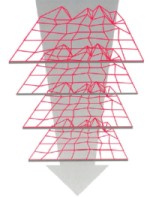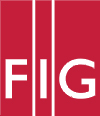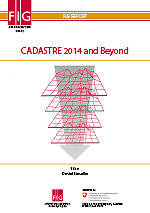FIG PUBLICATION NO. 61
CADASTRE 2014 and Beyond
FIG PUBLICATION SUPPORTED BY FEDERAL OFFICE OF TOPOGRAPHY,
SWISSTOPO WABERN, SWITZERLAND
Editor
Daniel Steudler
|
 |
What was a simple activity report of Working Group 1 within FIG
Commission 7 “Cadastre and Land Management” in 1998, has over the years been
translated into 28 languages and was a topic in many forums, panel
discussions, roundtables and journal articles. This simple activity report
became a visionary publication, found its way into conference halls and
lecture theatres, and became a reference publication in many teaching and
research institutions. It triggered researches, promoted additional
considerations on issues related to cadastral systems, including
developments such as the “Cadastral
Template” and in the field of “Spatial Data Infrastructures”. It also
impacted and led towards the recently published FIG Report on “Spatially
Enabled Societies” in May 2012. CADASTRE 2014 became a “brand” by itself.
Though CADASTRE 2014 represents the collective efforts and knowledge of
many, congratulations are in order, especially to both Jürg Kaufmann and
Daniel Steudler for their
untiring efforts over those many years that led to this definitive
publication. Also to be congratulated are Ian Williamson, the Chair of FIG
Commission 7 at that time as well as the FIG Council presided by Peter Dale.
CADASTRE 2014 represents not just ideas and concepts, but passion and
abilities to better comprehend and apply evolving cadastral concepts.
We are on the threshold of the Post-2015 UN Development Agenda. Last year,
the United Nations High-level Panel of Eminent Persons in its report focusing on
“New Global Partnership: Eradicate Poverty and Transform Economies through
Sustainable Development” proposed how new goals and measurable targets could be
framed in the wake of proposed transformative shifts. We do note that “Land” was
mentioned some 23 times within this document. I trust “CADASTRE 2014 and Beyond”
is the beginning of yet another collective and definitive efforts within FIG to
contribute towards unlocking
the potential of what “Land” is; by “Land” we also mean the seas and its natural
resources, for the well-being and betterment of humanity. Our profession is
tempted to look at our past and present achievements, but foresight is about
considering the challenges of the future, the evolving contribution and
relevance of the cadastre towards the “World We Want”.
It is most fitting that at the silver jubilee Congress of FIG to be held in
Kuala Lumpur, Malaysia this year with the theme “Engaging the Challenge:
Enhancing the Relevance” that we celebrate the immense success of CADASTRE 2014
Vision and launch this new publication on “CADASTRE 2014 and Beyond”.
We congratulate all contributors and in particular, Daniel Steudler, the
editor for all their efforts towards this publication. We extend our deep
appreciation and gratitude to our Membership and the corps of volunteers within
our Federation for their invaluable and unselfish contributions in this
publication and its related endeavours.
CheeHai Teo
President FIG
April, 2014
Introductory remarks
CADASTRE 2014 has been published in 1998 as a result of a working group of
FIG Commission 7. The working group, active from 1994–1998, had the mandate to
identify trends in the cadastral field and to suggest whereto the cadastre might
go for the next 20 years.
The working group carried out two questionnaires in order to identify the
trends and came up with six vision statements, provocative for some, innovative
for others. The publication presented and explained those six vision statements,
suggested some new definitions in order to make the visions possible, and also
made some recommendations for action.
As the year 2014 has arrived, it is very appropriate to take the topic up
once more, to review the statements, to evaluate them and to put them in
context. The XXV FIG Congress taking place in June 2014 is an excellent
opportunity to do that: two special sessions are part of the congress program
and the sections included in this publication will be presented and discussed.
Read the full FIG Publication 61 in pdf
Copyright © The International Federation of Surveyors (FIG)
2014, May 2014
All rights reserved
International Federation of Surveyors (FIG)
Kalvebod Brygge 31–33
DK-1780 Copenhagen V
DENMARK
Tel. + 45 38 86 10 81
E-mail: [email protected]
www.fig.net
Published in English
Copenhagen, Denmark
ISSN 1018-6530 (printed)
ISSN 2311-8423 (pdf)
ISBN 978-87-92853-12-7 (printed)
ISBN 978-87-92853-13-4 (pdf)
Published by
International Federation of Surveyors (FIG)
Front cover: The Cadastre 2014 graphic by Werbegraphik Bruno Teucher, Rüdlingen,
Switzerland. © Jürg Kaufmann and Daniel Steudler.
Design: International Federation of Surveyors, FIG and Lagarto
|


























